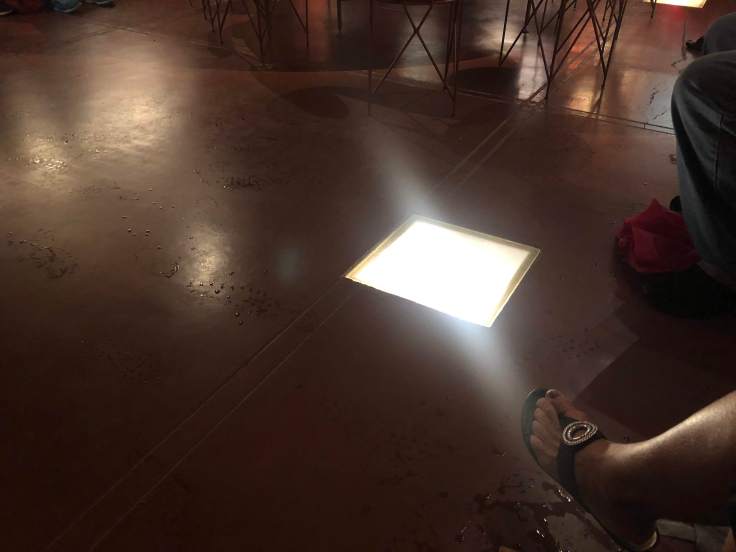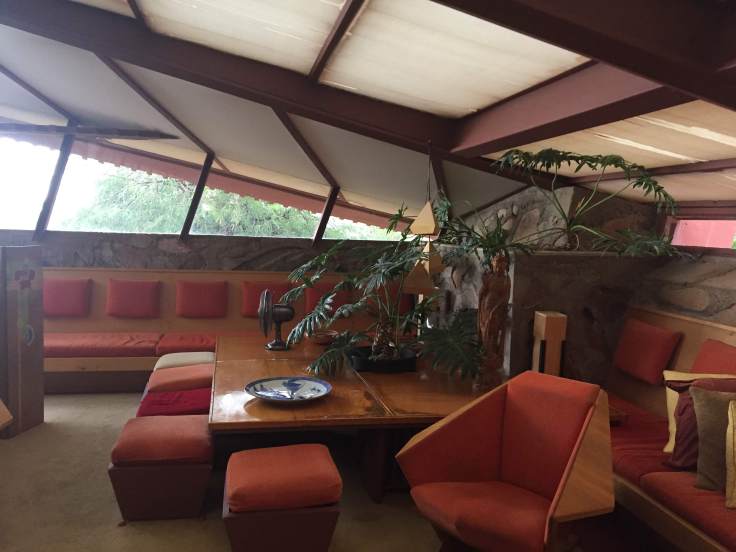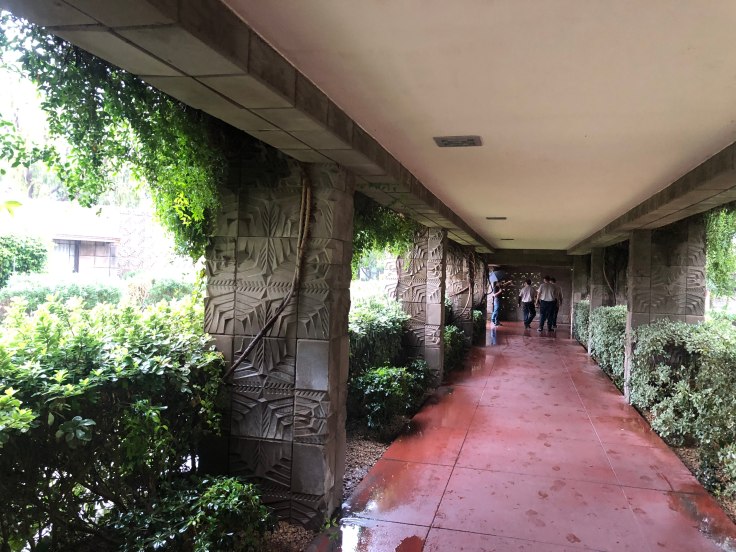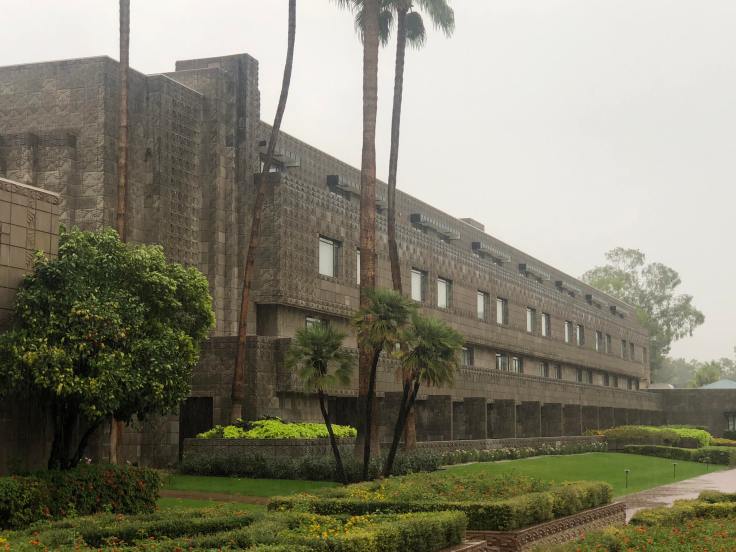It was slightly raining this morning when we left Sun City to drive to Taliesin West. We arrived in plenty of time for our tour. We were able to take a few pictures, but soon it was raining quite hard.




Taliesin is today a fully accredited School of Architecture, and it is not affiliated with any university. It has between 20 and 30 students at any one time, and they can earn a Masters Degree. The students live and work and study at each of the two campuses for 6 months each year, Summer in Wisconsin, Winter in Arizona…
We started the tour, but quickly retreated to the “Dance Pavilion”. This was a performance space, and it is about the last building built at Taliesin West by Frank Lloyd Wright.


What you need to know is that for FLlW, Taliesin West was his “desert camp”, and he enjoyed “camping” here in maximum communion with nature. The first few years they put together temporary structures with scrap lumber and canvas. They left it all when they returned to Wisconsin in the Spring, but when they returned in the fall they found that it had all been stolen and carted away by the locals…
So they began to build more permanent buildings, but they were still built to be open to nature. The roofs were sheets of canvas, walls and doors were open, maybe partially covered with canvas flaps. They had no electricity (except from generators) until the early 1950s.
So the dance pavilion was originally an open air pavilion. Only in later years was it enclosed by glass. The canvas roofs still remain today, and everyone enjoys the softly filtered light that they provide…
We walked in the rain to the FLlW’s “Office”. This was not a work room, but was a conference room and presentation room… On the way we could see the canvas roofs. Originally they were just sheets of canvas. But they deteriorated quickly under the desert sun, so a panelized system was created to make for easy replacements of individual sections. Today the canvas is covered by translucent acrylic, and the canvas still needs to be replaced about every five years…

Inside, the canvas is supported by steel beams and internal gutters to channel away (most of) the water that seeps through…

All of the solid walls at Taliesin West are concrete, formed with rocks gleaned from the desert by the Taliesin students. This has proven to be an economical system that has stood the test of time. This being Arizona, there is no rebar in these concrete walls…

The entrance to the Office is through this odd-shaped door. The door is barely six feet tall, and the ceiling is not much higher. FLlW’s secretary sat in this entry space, in a “cave” constructed of this large rock concrete. This entry exhibits FLlW’s famous “compress and release” concept as you move through the low-ceilinged space into the larger space beyond…


It is a very nice space… Of course, because it was raining, I had to position my chair so that I would not be dripped on…




The table you see covered with a tarp to protect it from the rain is VERY low, as are the chairs. FLlW designed it this way so that when clients looked at the drawings placed on the table they could see them very well as an overview, but if they wanted to examine them more closely they would have to stoop, and it would be very uncomfortable. He didn’t want his clients looking too closely at the drawings…

Our next stop was the drafting room. This room is generally off limits when the students are present, but the students are still in Wisconsin, and they won’t arrive for a few weeks yet… We walked in the rain and passed the concrete walls of the drawing vault. Paper drawings must always be protected from fire and other elements. (Today we use computers to draw and make presentations, so they are much safer, if backed-up properly…)


The drafting room has the same style of canvas roof. The glass ares were originally open, with canvas flaps…












It is a marvelous space!
We then moved to the “Kiva”. This is the original “man cave”, where FLlW would show movies for his students and guests. Originally this was a windowless storage room. When they would leave in the spring they would put anything of value that they were not taking with them in here for security… Later they added the projection room and they experimented with lighting…

Floor lights…

Cove lighting, with “cut-out” shapes to form shadows. Are these triangles representative of teepees? Or mountain peaks?

Corner lighting…

We moved on to the Dining Room…


The Dining Room is entered from this Breezeway. The Breezeway has always been here, but the ceiling was raised after FLlW’s death in 1959. Apparently his son-in-law, Wesley Peters, who was an MIT-trained engineer, and who was FLlW’s right-hand-man for all things engineering, was 6′-5″ tall, and he hated that he always had to stoop when he was around FLlW. He wanted a space to sit and enjoy the desert in front of a fireplace and remember FLlW. So he had the ceiling raised to make this space…

The fireplace…

The views…


We entered the Dining Room to enjoy a break and a little refreshment…




The Dining Room wasn’t always here… It was originally on the opposite side of the house, overlooking the southern views across the desert. But, in 1948, the local power company strung power poles across the edge of the property to facilitate the rapid post-war expansion of Scottsdale. FLlW was so incensed at this, after exhausting all avenues of protest, including a letter to President Truman, that he redesigned the buildings and landscaping to reverse the orientation and avoid the views of power poles. (Truman’s response to his letter: “Do you really think I have nothing better to do than to worry about your view?”) Today the power poles have been replaced by giant steel high-tension wire structures… They are quite ugly…)
So we enjoyed our refreshment… We had a VERY interesting talk by a woman who was born at Taliesin. She lives here today, where she works in the archives department. Her mother and father were some of the first students here in 1937. They stayed on after their school days were over, having two children here. They moved away briefly during WWII; they subsequently divorced, and her mother moved back and lived and worked here the rest of her life. She passed away just last year, well into her nineties. There are three other original students who came and never left who still live here…
We saw many photos of life at Taliesin in the old days, and many interesting stories. Originally, the students pitched tents out in the desert (there were no dormitories…) or they built “Desert Shelters” in which to live. No electricity, running water, or kitchens. Students still live out in the desert today… If you come to see Taliesin West in the winter you can tour the student “homes”…
We thoroughly enjoyed her talk…
But it was time to move on… We left the Dining Room via the Breezeway and went to the entrance to Mr. and Mrs. Wright’s home…

As usual, the front door is hard to find, and is very small…

This is the Garden Room, or the entertaining space. Parties, called, “Taliesin Nights”, were held here most Saturday evenings. Celebrities, friends, and students mixed, all in formal attire. In the early days FLlW would send a large flat bed truck the four miles to Scottsdale to pick up the guests, so that they would not have to navigate the narrow, steep, dirt road…
The room has a canvas roof; glass was added in the late 1940s, and central heat and AC was added by Mrs Wright in the 1970s… It is a lovely room…

Water is added whenever it rains…












Adjacent to the Garden Room is the Wrights’ private sitting room. Originally it was an open-air space, open to take in the nature of the desert…



But Mrs. Wright eventually tired of the exposure to the desert and asked that glass be installed. FLlW objected for many years… Finally, FLlW consented, and ordered the apprentices to install the glass. When they asked what they should do with the pots on the shelves, FLlW angrily answered, “Leave them exactly where they are”! Thus:



The Wrights’ bedroom and Mrs. Wrights sitting room, face onto the desert, but the views have been constructed, using fencing and trees, to obscure the power poles… The “Moon Gate” allowed the Wrights’ children to access the adjacent courtyard and their rooms. Mrs. Wright eventually built another bedroom suite for herself after FLlW’s death…


The Sprites seen here are two of the five remaining original Sprites (out of over 500) that were designed and built for the Midway Gardens project in Chicago in 1915. The others were all bulldosed into Lake Michigan, along with the rest of Midway Gardens, after prohibition doomed the project and the City wanted something else on the site…

This is the Master Bedroom…



The bathroom is sheathed in polished aluminum… as befitting an Airstream!

More lighting experiments in the bedroom: recessed lighting and up-lighting…


We then moved to one of the guest cottages. The rain is briefly letting up…















Walking back along the main house… This is about the only 2-story building… The upper floors contain apartments for staff and/or guests…

The dinner bell…



Our last building is the Cabaret…

This is an underground “supper club” where the students and staff would put on various types of entertainment… The acoustics are great!

Notice that the rows of seats are angled relative to the stage area. Mr. Wright always sat a certain way in venues like this, so the seating was designed to accommodate his habits. This was his way of dictating how you sit if you want a good view of the stage…










I couldn’t help peeking into the kitchen and service corridor…

As we left the Cabaret the rain stopped briefly, so we could take a few photos of the exteriors…

Ventilation holes in the vault…

The Office…

The Drafting Room…













The view of the power towers…



And then our three hour tour was over…
We left, sadly, in the rain…
We dropped in at The Arizona Biltmore, a Waldorf Astoria Resort… We immediately noticed the Sprites… Oh. And it was raining with a capital RAIN!

Warren McArthur, Jr. and his brother Charles McArthur along with John McEntee Bowman, opened the Arizona Biltmore on February 23, 1929.
The Arizona Biltmore’s architect of record is Albert Chase McArthur (brother of the hotel owners), yet the design is often mistakenly attributed to Frank Lloyd Wright. This is due to Wright’s on-site consulting for four months in 1928 relating to the “Textile Block” construction used in the hotel. Albert McArthur had been a draftsman for Wright, and specifically asked Wright to assist with implementing the textile block system, which became a signature element of the hotel’s appearance. The hotel has similarities to several Wright buildings, especially in the main lobby, owing to a strong imprint of the unit block design that Wright had utilized on four residential buildings in the Los Angeles area six years earlier. McArthur is indisputably the architect as original linen drawings of the hotel in the Arizona State University Library archives attest, as does a 1929 feature article in Architectural Record magazine. The two architects are a study in contrast with the famous and outspoken Wright being self-taught and never licensed as an architect in Arizona. The more soft-spoken McArthur was Harvard trained in architecture, mathematics, engineering, and music. McArthur obtained an architect’s license in Arizona, number 338, in 1925, the year he arrived in Phoenix to begin his practice.
Reproductions of the geometric ‘sprite’ statues originally designed by sculptor Alfonso Iannelli for Wright’s 1915 Midway Gardens project in Chicago are placed around the property. Also, the original hotel solarium was converted to a restaurant in 1973 and since the mid-1990s has been named ‘Wright’s’. Three on site restaurants bear Wright’s name, Wright’s at the Biltmore, The Wright Bar, and Frank & Albert’s.
We were there to have lunch at Frank and Albert’s
We looked around and found many interesting details…









And then we enjoyed a very nice lunch…

Driving back to the Villa proved to be quite an adventure…
















We did safely return to the Villa and spent the rest of the day and evening watching football…
And an enjoyable time was had by all…